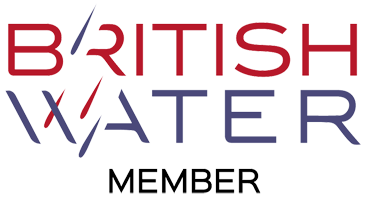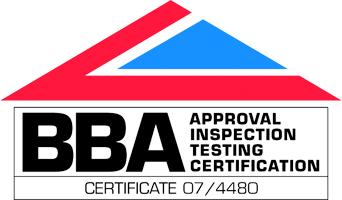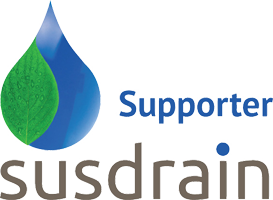Author Archives: admin
SuDS tips #6: Green infrastructure
A qualified civil engineer, Stuart Crisp has been at the forefront of construction and a specialist in drainage systems for over 35 years. He has contributed to the development of numerous British and International Standards and industry specifications, and was a member of the project steering group for CIRIA C753 The SuDS Manual. In this regular series of articles, Stuart considers the different challenges facing designers and installers of below ground SuDS attenuation systems. This month covers the differing approaches to green infrastructure.
Traditionally, the predominant approach to management of storm water runoff in the UK has been through engineered sewer-based systems that would now be classed as ‘Grey Infrastructure’. In the brave new world of sustainable drainage systems, SuDS attenuation systems that are still generally considered as grey infrastructure typically collect rainfall from impervious surfaces, such as road-ways, hard standings and rooftops, and then store and discharge it below the ground via a series of crates, pipes or arches through infiltration, or into a local water body via a sewer or surface channel at a controlled flow rate.
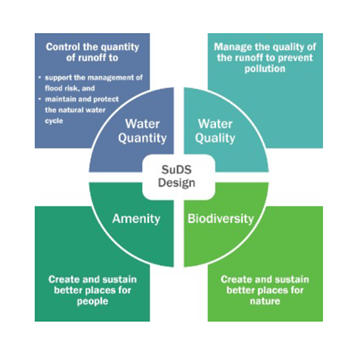
CIRIA, however, has long-suggested ‘Green Infrastructure’ (GI) as a preferred SuDS solution to effectively manage the impacts of climate change, growing flood risk and policy changes and legislation that place an emphasis on water quality, as well as effective management. GI is defined as “a strategically planned and delivered network of natural and man-made green (land) and blue (water) spaces that sustain natural processes.” The application of GI is recognised in government policy and advocated by bodies such as the Landscape Institute.
Thus, GI is a complementary, alternative stormwater solution, promoting the idea of natural flood management. GI mimics natural hydrology and seeks to
improve water quality and reduce water quantity by capturing runoff as close to the source as possible and infiltrating, filtering, and storing it for re-use. SuDS practitioners often regard GI using vegetative, surface-based solutions as Best Practice. The methods include diversion ponds, wetlands, detention basins, filter strips, grass channels and swales.
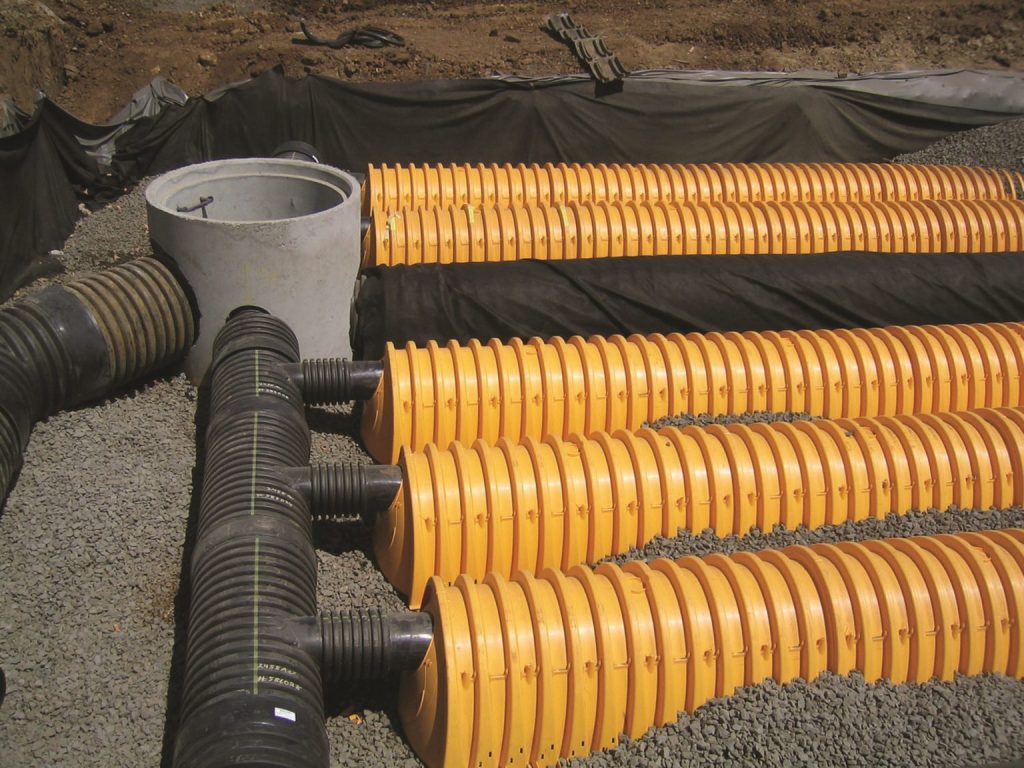
The “Four Pillars of SuDS Best Practice” is a recognised model that illustrates the potential for a SuDS system to provide (1) Management of Water Quantity (i.e. mitigation against flooding); (2) Management of Water Quality (i.e. mitigation against pollution); (3) Biodiversity (i.e. attracting wildlife); (4) Amenity (i.e. providing useful space for activities). When below ground attenuation systems are used within a SuDS scheme, it is unlikely that the biodiversity pillar can be satisfied without the combined use of vegetative SuDS components. In terms of amenity, interpretation of this pillar may be rather ambiguous. Some say that the intention is to create blue/green, landscaped open spaces that can enhance the environment and a sense of wellbeing within the community. Others would argue that functional usefulness is no less an amenity, often driven by developers seeking to maximise land usage, such as a car park built over a below ground attenuation system. In terms of the water quality pillar, many below ground attenuation systems provide no water quality treatment and rely on other parts of the SuDS Management Train to remove pollutants from surface water runoff.

Sometimes the hydraulic load, geographic demands or project requirements mean that a GI system is not able to meet the required performance parameters. In these situations, pipes, crates and chambers can be an integral part of a GI project, providing additional scope for enhanced performance or the resolution of technical constraints. For example, where the infiltration capacity of the ground is poor and a downstream connection to a sewer or water body is not practicable, the additional storage capacity provided by a system installed below the surface-based SuDS feature, can be used to retain a larger volume of stormwater, and enable infiltration at a slower rate.
Whilst some systems can help with the storage and movement of surface water, they cannot address water quality unless part of a treatment train. Water quality management can be achieved through an appropriate combination of vegetative SuDS components and/or proprietary manufactured treatment devices. For example, with its unique Isolator Row in-built water treatment device providing two treatment stages, plus a further two treatment stages provided within the embedment stone, a system like ADS StormTech can also be used in combination with vegetative SuDS installations to enhance both the water storage capacity and pollutant removal performance.
Below ground systems with treatment devices can therefore be used in a variety of GI applications. Pervious surfaces, for example, allow the movement of water through the soil and a below ground storage and attenuation system can be installed underneath.
Downpipes directing stormwater from the roof of a building can also form an integral part of a GI system, helping to replenish groundwater in a controlled manner, whilst filtering out sediments and nutrients from the water to decrease pollutant loads. These systems can also be used as part of a sealed tank system providing rainwater harvesting.
An excellent example GI in the broader context of rainwater harvesting and water management is the recently opened 4.5-acreFrancisco Park, where the old San Francisco Reservoir was transformed into a sustainable and cost effective community space with a stormwater capture and reuse system that will perpetually provide water for the park’s irrigation and toilets, all while helping manage stormwater and preserving the natural flora and fauna.

The stormwater is stored in a 1.9M litre cistern at the top of the hill before being transferred to the service building, where it flows through a series of filtration and disinfecting processes. This includes three StormTech Isolator Rows which capture the “first flush” and trap sediment and other pollutants coming from stormwater runoff. This approach ensured that the water met public health regulations, while saving 5.7M litres of potable water every year.
Three hundred and seventy-two StormTech chambers were installed in a 35m x 45m area of the existing reservoir and then covered with soil. This gave a total storage capacity of 2,000m3
of water in a 1,682m2 footprint. StormTech chambers were chosen because of their ratio of storage volume to footprint area. “There are competing products on the market,” explains Sherwood Design Engineers (SanFrancisco) principal Cody Anderson, and StormTech was chosen as “We needed to store as much water as possible in the given area. We work on projects around the globe with an emphasis on sustainable development and we’re known for having the vision and the technical capacity. The Francisco Park is one of those projects of a lifetime. It’s reclaiming an area in the city of San Francisco that is now a beautiful park for the people.”
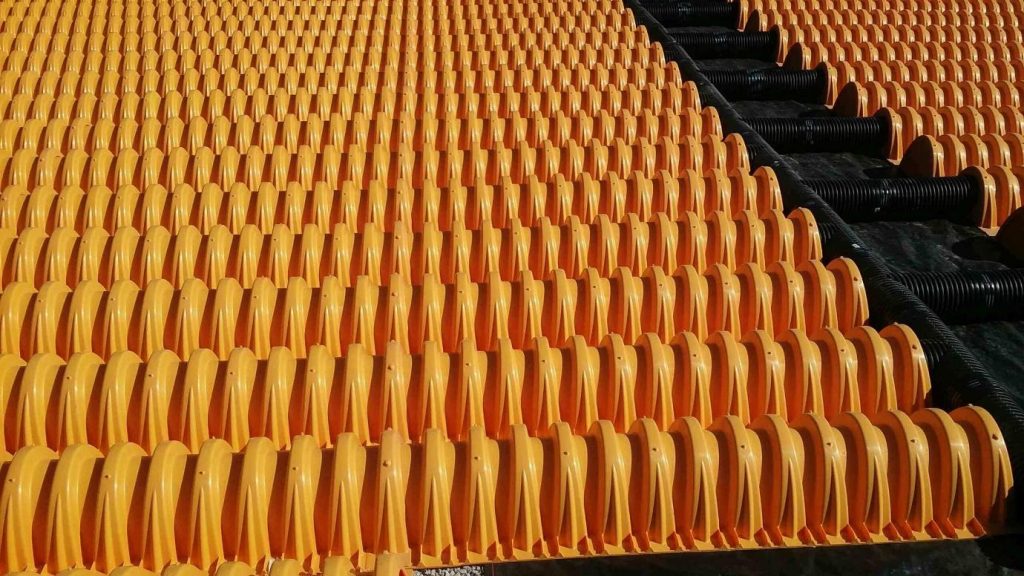
Stuart Crisp is UK Manager for Advanced Drainage Systems (ADS). ADS is America’s largest manufacturer of thermoplastic corrugated drainage pipes and a specialist in water management systems. StormTech has a long and successful track record with over 40,000 below ground SuDS attenuation system installations using in excess of 2.5m units.
Originally published in Water magazine August 2022
SuDS tips #5: Design Flexibility
A qualified civil engineer, Stuart Crisp has been at the forefront of construction and a specialist in drainage systems for over 35 years. He has contributed to the development of numerous British and International Standards and industry specifications and was a member of the project steering group for CIRIA C753 The SuDS Manual. In this regular series of articles, Stuart considers the different challenges facing designers and installers of below ground SuDS attenuation systems. This month covers the importance of design flexibility.
When designing a below ground stormwater attenuation system, it’s important to consider not only the hydraulic and structural requirements, but the site conditions, the construction process, the necessity for maintenance, the environmental concerns and the technical, legal and client constraints.
The flexibility of the system to accommodate a multiplicity of factors is thus central to the solution – can the design be optimised to meet the relevant conditions and controls? A truly adaptable stormwater attenuation system will mean engineers can produce the most effective design, contractors can install the system with speed and ease, and asset owners can inspect and maintain the system efficiently, whatever the conditions.
Traditional pipe- and crate- based solutions have their drawbacks. Large diameter pipes are less efficient in terms of the ratio of footprint area to attenuated storage volume. Geocellular crates may have greater versatility to meet challenges in terms of accommodating storage within the space available, but the necessity for additional TSS removal and separate water quality treatment to meet environmental quality standards can add to the cost of construction and upkeep.
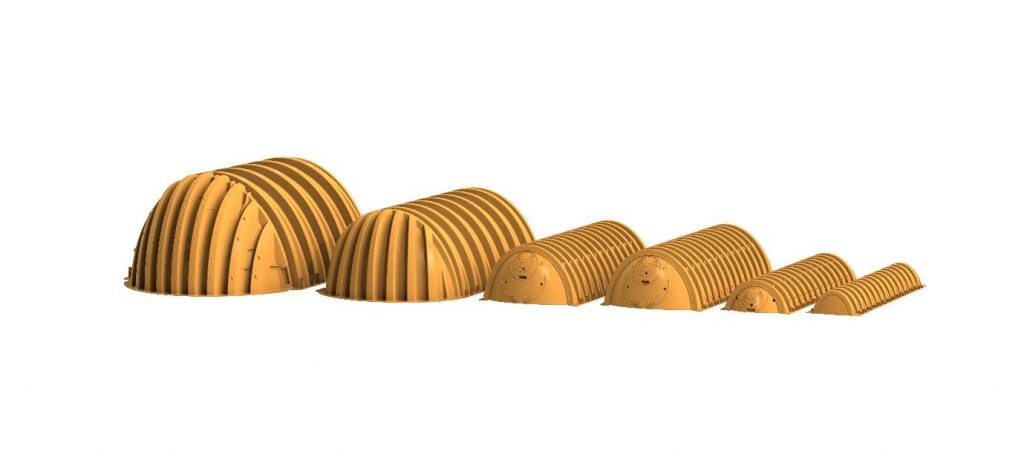
With the importance of design flexibility, ADS StormTech comes in a wide range of chamber sizes giving engineers the scope and flexibility to meet required attenuation volume and flow rates, the constraints of the site, the installation footprint and depth, and the position of inlets and outlets. Isolator Row, the free water quality treatment device, provides a provenly effective and low maintenance solution for meeting environmental standards. Layouts can be adapted to suit local conditions, potentially going beyond the published standard construction guidelines. For example, deep installations or poor soil strength may be accommodated by altering the spacing between the chambers, the depth of the foundation material and the degree of compaction of the embedment stone.
This is particularly true when minimising the construction depth of the attenuation system. This largely depends on two factors: minimum cover depth and the height of the stormwater storage system. Shallow systems may help avoid contact with high groundwater, and lower dig depth can reduce dewatering costs and installation delays in saturated ground. Shallow systems can also minimise the cost of excavation, muck-away and embedment/backfill, including fewer transport movements to and from the site. Reducing the depth of the attenuation system may also enable the invert depth of the entire storm water drainage system to be raised, resulting in additional cost savings extending beyond the attenuation system itself.

Many StormTech chambers have 450mm min cover depth under HGV traffic loads based on the standard manufacturer’s installation guidelines. Pipes and crates normally need c600mm – 800mm min cover depth. For crates, if the depth of cover available is less than the minimum recommended by the manufacturer, a protective concrete slab is frequently placed above the crate system. This is expensive and time-consuming to construct and makes it almost impossible to access the system from above after installation.
Quality Assurance is inevitably a key part of true design flexibility. StormTech fully complies with the requirements of ASTM F2787, ASTM2418 and ASTM F2922 and Section 12.12 of the AASHTO LRFD Bridge Design Specifications safety factors for live and permanent earth loads. These Standards provide the basis of product quality and of safe structural design. Further assurance is provided in the UK through rigorous independent testing and assessment within the scope of BBA certification.

Stuart Crisp is UK Manager for Advanced Drainage Systems (ADS). ADS is America’s largest manufacturer of thermoplastic corrugated drainage pipes and a specialist in water management systems. StormTech has a long and successful track record with over 40,000 below ground SuDS attenuation system installations using in excess of 2.5m units.
Originally published in Water magazine July 2022
SuDS tips #4: Water Quality Management Solutions
A qualified civil engineer, Stuart Crisp has been at the forefront of construction and a specialist in drainage systems for over 35 years. He has contributed to the development of numerous British and International Standards and industry specifications and was a member of the project steering group for CIRIA C753 The SuDS Manual. In this regular series of articles, Stuart considers the different challenges facing designers and installers of below ground SuDS attenuation systems. This month covers water quality management.
Water Quality Management – mitigating the impact of pollutants in surface water runoff to prevent harmful discharges into the environment – is one of the fundamental principles of SuDS Best Practice. Essentially, this covers three key material groups:
- suspended solids – silt and other particulate material flushed off the drainage catchment surface
- hydrocarbons – oil and petroleum-based materials deposited (or spilt) on the ground, usually as a result of vehicles and machinery in operation, or worked on, in the vicinity.
- Metals – a range of metals-based materials that can cause harm to the environment, including copper, zinc, lead.
Increasingly, Water Quality Management is a key focus for SuDS systems. Planners are looking to provide “nutrient neutrality” i.e., reducing existing sources of nutrient pollution to mitigate the nutrients generated by new development. In these more demanding cases, removal of additional substances such as compounds of phosphorous and nitrogen are often required.
It is the job of key stakeholders in the Project Team to ensure that the water quality discharge meets the requirements of legislation, client, and the local environmental regulator.
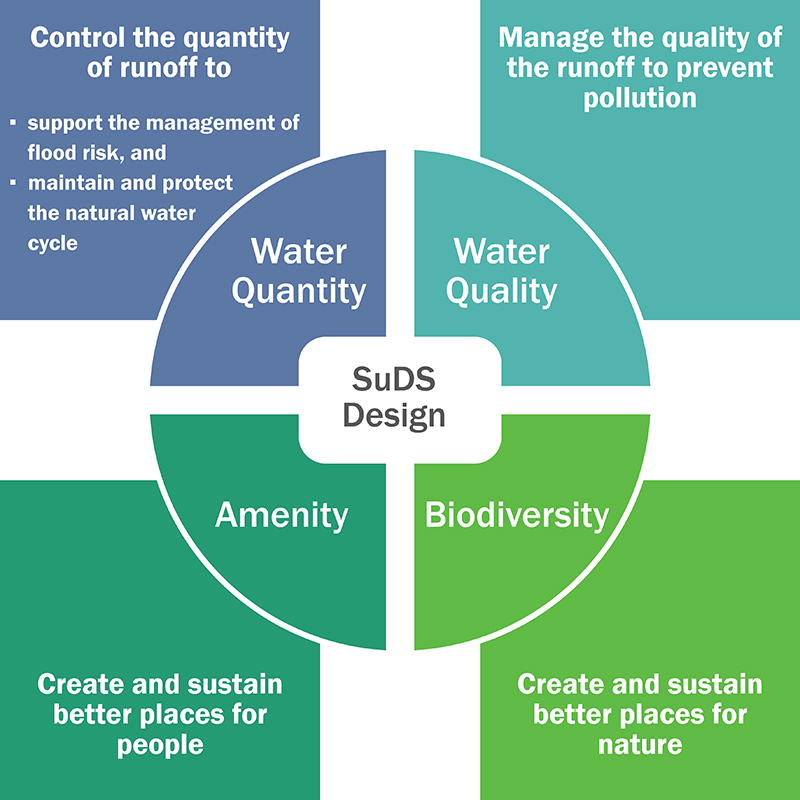
Numerous reference sources exist that can help users determine the most appropriate water quality mitigation measures for a specific project. These include the CIRIA publication C753 The SuDS Manual. Chapter 4 deals with Designing for Water Quality and Chapter 26 deals with Water Quality Management. Chapter 14 relates to Proprietary Treatment Systems. Other Chapters provide guidance on specific vegetative “soft” SuDS components such as Detention basins, Swales, Infiltration systems and Filter strips. Vegetative SuDS are generally regarded as preferable in terms of SuDS Best Practice, as they are surface based solutions that manage rainfall closest to where it lands, also referred to as “source management”. Like any system, vegetative SuDS will require maintenance to ensure that they meet their design function throughout the lifetime of a development.
Designing an effective below ground SuDS attenuation system that meets the demands of both flood risk mitigation (Water Quantity Management) and pollution risk mitigation (Water Quality Management) requires a Management Train approach, where proprietary Water Quality Treatment device(s) are usually installed upstream of the below ground Attenuation Tank. This would typically require a sediment capture system, which may be as basic (and potentially inadequate?) as a catch pit or more appropriately, a proprietary gravity separation sediment tank or hydrodynamic separator. Hydrocarbon removal will require a bypass or full-retention oil/water separator, depending on the intended use of the development and the level of risk of hydrocarbon pollution.
Below ground attenuation systems such as crates and pipes offer little in the way of water quality treatment capability, so the demands of water quality must be covered by separate, additional SuDS components elsewhere in the system.
Not only can this require significant capital investment in the treatment system (each manufactured treatment device can cost >£10k, and multiple units may be required on a project), there is an additional operational cost in terms of inspection and maintenance. Failure to properly maintain water quality treatment systems can lead to problems with the attenuation tank, such as sedimentation within the tank, resulting in reduced storage volume– causing the system to fail hydraulically – and the possibility that pollutants are flushed downstream, resulting in water quality breaches and fines.
Some systems, however, include an integrated solution. New to the UK, the ADS StormTech stormwater attenuation system incorporates the unique Isolator Row, a patented, built-in water quality treatment device designed to remove silt and other polluting material flushed off the surface during rainfall.
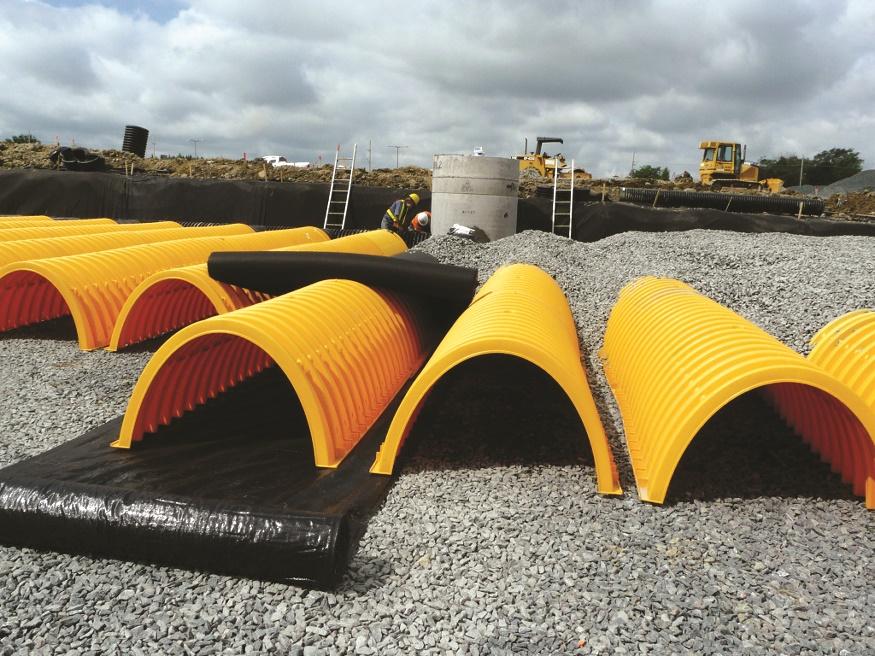
Isolator Row has 2 treatment stages, contributing to the overall efficiency of the system. These include initial gravity separation of the silt and particulates within the Isolator Row chamber and filtration through a layer of woven geotextile fabric on the bed of the chamber, laid over a stone foundation. Two further treatment stages can take place within the stone embedment surrounding the StormTech chambers. As flow passes through the system, pollutants can adsorb onto the face of the stone, meaning that they are “trapped” and prevented from passing through to the discharge point. This material can provide nutrient for bacteria and over time, will be broken down into harmless, non-polluting material.
The four treatment stages of a StormTech system:
- Gravity separation (sedimentation) Isolator Row (2 stages)
- Filtration
- Adsorption Embedment stone surrounding StormTech system
- Biodegredation
Isolator Row has been independently tested by universities and respected industry bodies (including NJCAT) and validated to remove over 80% of Total Suspended Solids (TSS) plus metals, hydrocarbons, phosphorus, nitrogen, and other surface water pollutants.
Where nutrient neutrality is sought and there is a demand for higher levels of pollutant removal, or where more challenging pollutants need to be dealt with, other water treatment solutions may be required. These can include proprietary filtration systems designed specifically to address certain chemical species and material phases within the surface water runoff. In these situations, when considering a proprietary manufactured treatment device, it is recommended that advice is sought directly from the manufacturer.
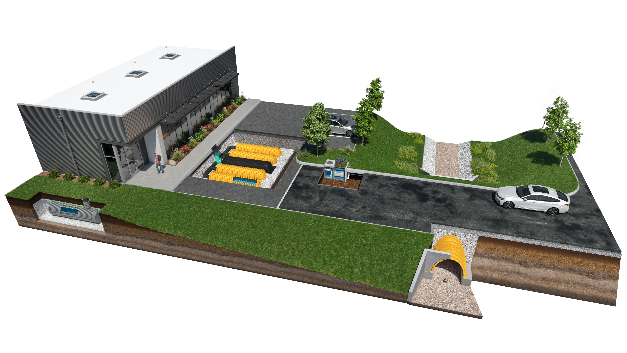
For practitioners in the UK, it may be helpful to refer to the British Water Code of Practice: Assessment Of Manufactured Treatment Devices Designed To Treat Surface Water Runoff. This publication sets out an assessment method to measure pollutant capture and retention. Additionally, read in conjunction with the Code of Practice and the CIRIA SuDS Manual, it is possible to derive mitigation indices using the British Water How To Guide: Applying The CIRIA SuDS Manual (C753) Simple Index Approach To Proprietary/Manufactured Stormwater Treatment Devices.
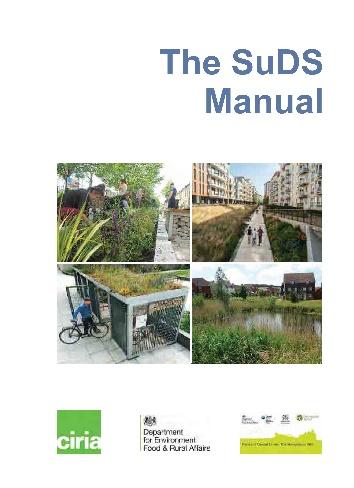
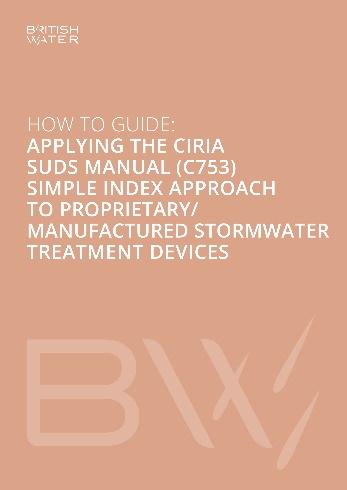
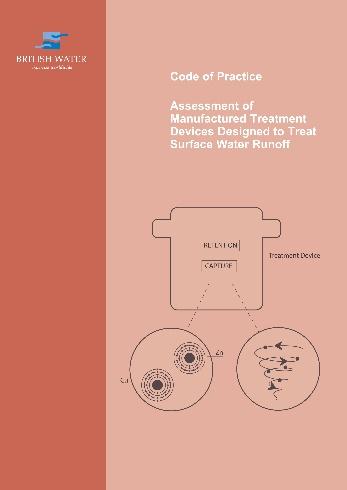

Stuart Crisp is UK Manager for Advanced Drainage Systems (ADS). ADS is America’s largest manufacturer of thermoplastic corrugated drainage pipes and a specialist in water management systems. StormTech has a long and successful track record with over 40,000 below ground SuDS attenuation system installations using in excess of 2.5m units.
Originally published in Water magazine June 2022
SuDS tips #3: Designing low-maintenance solutions
A qualified civil engineer, Stuart Crisp has been at the forefront of construction and a specialist in drainage systems for over 35 years. He has contributed to the development of numerous British and International Standards and industry specifications and was a member of the project steering group for CIRIA C753 The SuDS Manual. In this regular series of articles, Stuart considers the different challenges facing designers and installers of below ground SuDS attenuation systems. This month covers the subject of inspection and maintenance.
When designing a stormwater attenuation system, sometimes too little attention is paid to cleaning and the costs of ongoing maintenance. System maintenance is essential to ensure that the intended performance is retained throughout the service life and that the risks of flooding and pollution are avoided.
This vital part of asset management can be overlooked at both the design and procurement stages, as the choice is often based on the incorrect assumption that all below-ground attenuation systems are equally easy and low-cost to maintain.
However, this is not the case. For example, because of their structure, stormwater attenuation crates are difficult to get access into the body of the tank for cleaning and require upstream silt removal to prevent a downstream build-up of material within the tank body. Whilst large diameter pipes are easier than crates to access, they too require upstream intervention for silt and hydrocarbon removal.
Both pipes and crates are therefore dependent on the additional expenditure and maintenance of an upstream silt separation and removal system. If silt gets into the storage tank, it can compromise the flow path and reduce the storage volumes – eventually causing the whole system to fail.
But that’s not all. Silt particles can carry pollutants and if these get into the storage tank, they may flush downstream and result in water quality breaches, pollution, and fines.
Crates and pipes, therefore, depend heavily on expensive upstream pre-treatment systems which, together with the attenuation tank, require regular inspection and maintenance. Conversely, the ADS StormTech stormwater attenuation system may not require additional upstream pre-treatment, therefore reducing capital and operational costs.
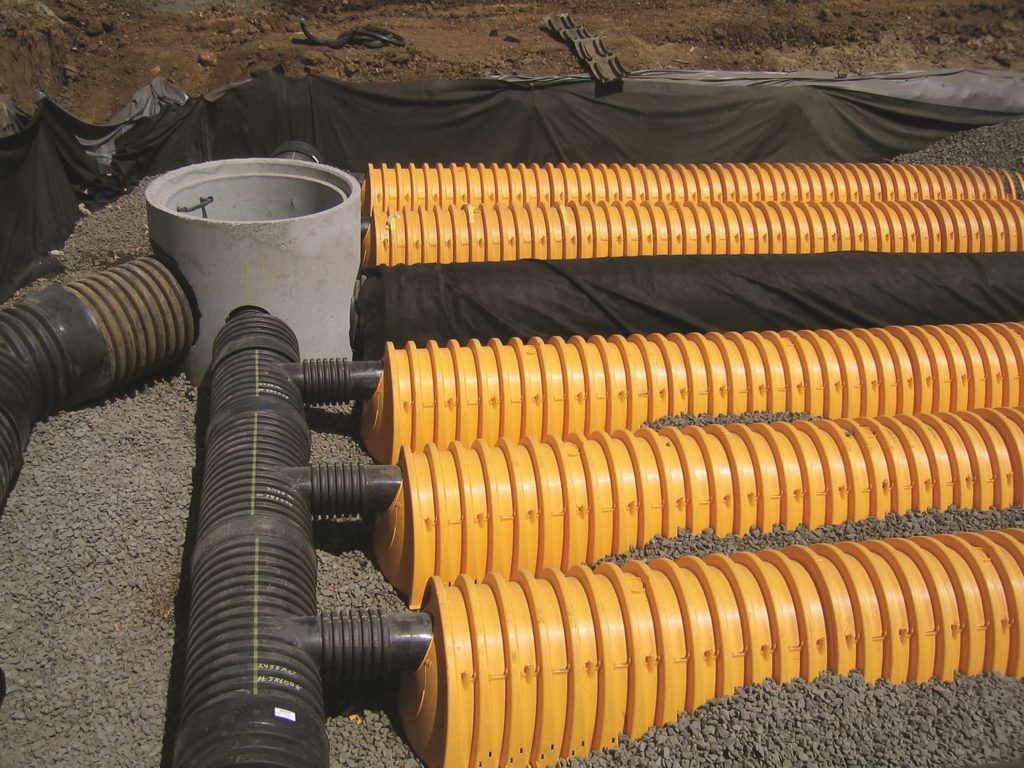
This is because ADS StormTech is engineered to provide an efficient, durable, low-maintenance solution for commercial, residential, industrial, and infrastructure installations. A key part of this is the unique Isolator Row, a ‘free’ built-in water quality treatment device designed to remove silt, sediment, and polluting material flushed off the surface during rainfall. Isolator Row is “sacrificial”, meaning that other StormTech chambers within the system are protected from solid particles and pollutants in the runoff entering, and they will not require any cleaning during their service life. This keeps maintenance to a minimum. Furthermore, Isolator Row has been independently tested by universities and respected industry bodies, including NJCAT, and validated to remove over 80% of Total Suspended Solids (TSS) plus metals, hydrocarbons, phosphorus, nitrogen, and other surface water pollutants. Isolator Row, as an integral part of the StormTech system, is recognised by many authorities as a water quality treatment device.
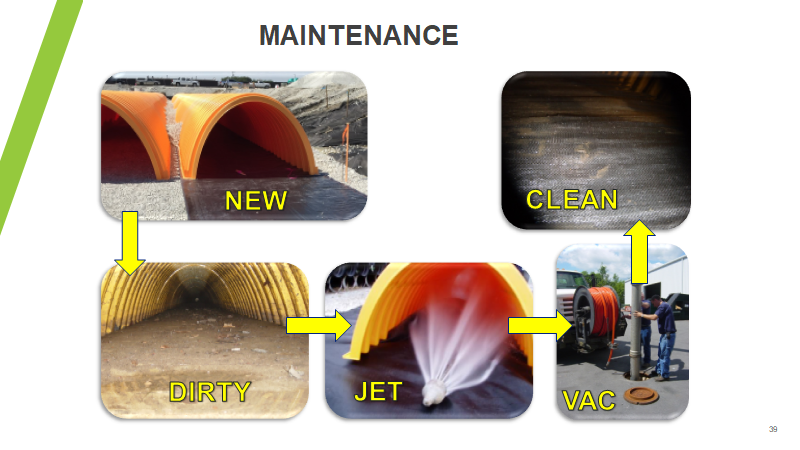
After many years of successful use in over 40,000 installations worldwide, Isolator Row has been proven to need cleaning on average once every 3-7 years, depending on the nature of the installation, using standard sewer cleaning equipment, saving asset owners both time and money in stormwater system maintenance.

Stuart Crisp is UK Manager for Advanced Drainage Systems (ADS). ADS is America’s largest manufacturer of thermoplastic corrugated drainage pipes and a specialist in water management systems. StormTech has a long and successful track record with over 40,000 below-ground SuDS attenuation system installations using in excess of 2.5m units.
Originally published in Water magazine, May 2022
Converting stormwater into a sustainable water supply
The Francisco Street Reservoir now serves as a source of useful non-potable water at a park for the local community, thanks to a stormwater collection system underneath.
Francisco Street reservoir was the first large reservoir in San Francisco, California when originally built in 1859. Decommissioned in the 1950s, the site was to be redeveloped but the Francisco Park Conservancy fought to keep it as a natural resource that would include harvesting rainwater. Underneath the 1.8 hectares Francisco Park is a stormwater capture and reuse system which was installed in 2021 to perpetually provide water for the park’s irrigation and toilets.
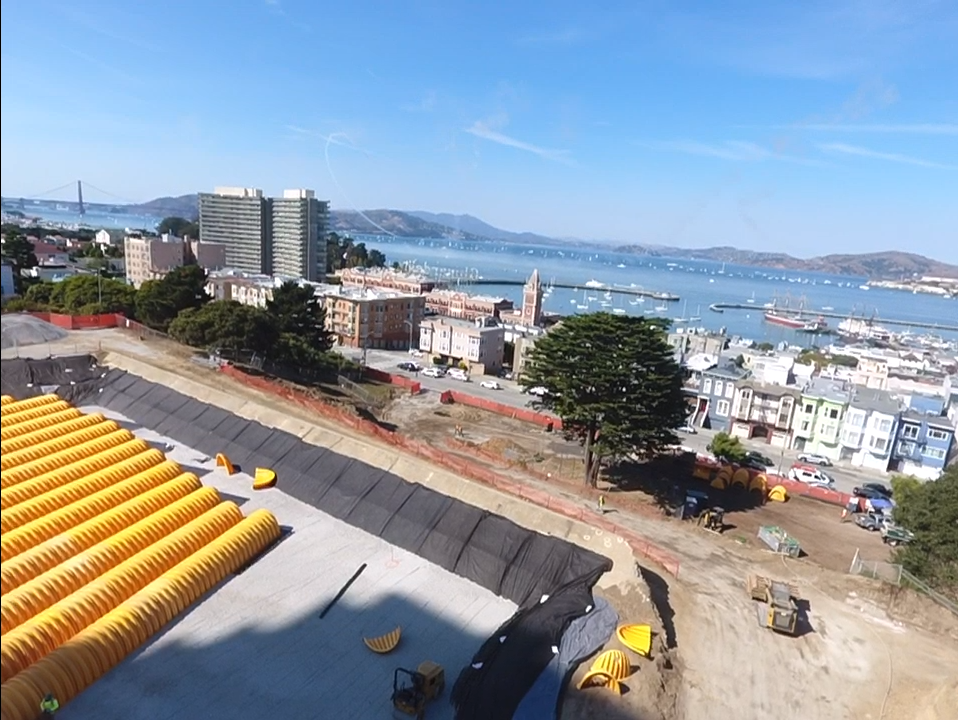
How the stormwater system works
The stormwater is stored in a 1.9M litre cistern at the top of the hill before being transferred to the service building, where it flows through a series of filtration and disinfecting processes. This ensures that the water meets public health regulations, while saving 5.7M litres of potable water every year.
The engineers decided to use a system of arched chambers because they would provide the largest storage volume per square metre.
“The reservoir is on a slope that is just under 20%. It’s a very challenging site from a variety of perspectives,” explains Sherwood Design Engineers (San Francisco) principal Cody Anderson who is responsible for the stormwater system.
“Normally you’d have your catch basin at the bottom of the site. Here, the historic reservoir is midway up the slope, so half the runoff is collected via gravity flow and the rest collected at the bottom of the site and pumped. All captured runoff flows through the screening filtration and into the chambers for storage and later use.”
Equipment used
Three hundred and seventy two ADS StormTech chambers, were installed using a 35m by 45m area of the existing reservoir and then covered with soil. This gave a total storage capacity of 2,000m3 of water in a 1,682m2 footprint. ADS StormTech chambers provided the best ratio of storage volume to footprint area.
The StormTech chambers are independently tested, BBA-approved and fully compliant with ASTM F2787, F2418 and F2922 stormwater storage systems standards. StormTech is typically used for below ground SuDS attenuation projects and more than 2.5M chambers have been used successfully around the world in over 40,000 projects. Three StormTech Isolator Rows are included in the Francisco Street reservoir system. These patented water quality treatment devices are integral to the StormTech system. They capture the “first flush” and trap sediment and other pollutants coming from stormwater runoff.
StormTech chambers come in a wide range of sizes, making them easy to install for all conditions. They are highly adaptable and can be configured around obstacles as well as affording multiple inlet and outlet positions. Standard pipe manifolds, manhole and access chamber inlet/outlet structures and flow controls can be used.

Reclaiming an area of San Francisco
“There are competing products on the market,” says Anderson. “We needed to store as much water as possible in the given area. We work on projects around the globe with an emphasis on sustainable development and we’re known for having the vision and the technical capacity.
“The Francisco Park is one of those projects of a lifetime. It’s reclaiming an area in the city of San Francisco that is now a beautiful park for the people.”
For more information on Advanced Drainage Systems, visit www.adspipe.co.uk.
SuDS tips #2: Efficient SuDS Systems depend on Effective Design
A qualified civil engineer, Stuart Crisp has been at the forefront of construction and a specialist in drainage systems for over 35 years. He has contributed to the development of numerous British and International Standards and industry specifications, and was a member of the project steering group for CIRIA C753 The SuDS Manual. In this regular series of articles, Stuart considers the different challenges facing designers and installers of below ground SuDS attenuation systems. This month covers speed and efficiency of construction.
Everyone knows that time is money. However, there’s rarely been such pressure on build time.
Sites are starting late. COVID 19 and Brexit has created labour shortages and manufacturers are struggling to meet demand. And with Britain now officially 6% wetter than in the previous 30 years, weather-related delays are only going to increase – particularly at this time of year. It’s no surprise that across the industry, site programmes are impacted, and contractors are struggling to meet deadlines and avoid penalty clauses.
Considering the speed of installation of the SuDS system at the design stage, can make life significantly easier for clients and contractors alike.
With large diameter pipes, site logistics, transport movements and storage space need to be factored in. Pipes are not the most efficient in terms of the amount of attenuated storage that can be achieved per delivery, and the footprint area required for a given attenuated storage volume is usually greater than most other forms of proprietary solution.
Vaulted systems can be slow to construct, and whilst geocellular crates are often quicker to install, difficulties with maintenance and the need for reliable pre-treatment often count against them. New to the UK, ADS StormTech chambers are fast and easy to work with, often requiring no mechanical lifting. They also provide easy access for inspection and are simple and low cost to maintain.
An important consideration in a drainage system is managing the hydraulic requirement against the available footprint area and construction depth. Traditionally, the flexibility of geocellular crates has made them a popular choice for tight footprints. However, ADS StormTech chambers are available in a range of sizes; the larger size chambers can accommodate the required attenuation volume in asmaller footprint, and the smaller chamber sizes can enable shallow construction depths in situations with high groundwater levels, minimum cover depth below traffic loads and shallow outfalls.
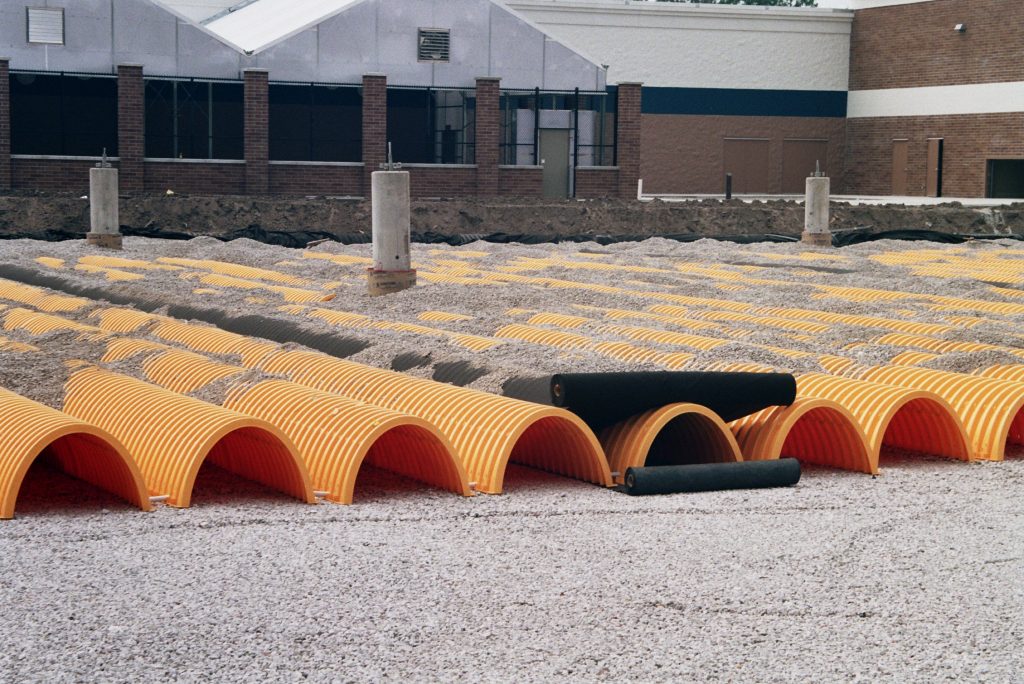
More flexible systems, such as ADS StormTech, are even able to maintain the necessary hydraulic flow around obstacles such as lighting columns.
The difference is particularly noticeable when it comes to more difficult terrain, especially when obstacles, such as lighting columns, below ground utilities and other structures need to be accommodated. Whilst solutions such a permeable block paving remain viable, large diameter pipes, geocellular crates and vaults are often unable to easily maintain continuous hydraulic flow through the system. StormTech chambers, are highly adaptable and can be configured around obstacles and afford multiple inlet and outlet positions. Standard pipe manifolds, manhole & access chamber inlet/outlet structures and flow controls can be used.
Whilst it’s perfectly possible to accommodate such terrain within a more traditional system, it can add time and complexity at both the design and installation stages. More flexible solutions may exist to optimise the design, improve efficiency and performance.
It’s important that the designer takes all these factors into consideration and is fully aware of the product types available and the pros and cons of each. An informed decision can then be made, fully understanding how the choice of system will impact on installed cost, performance, efficiency, buildability and maintenance.

Stuart Crisp is UK Manager for Advanced Drainage Systems (ADS). ADS is America’s largest manufacturer of thermoplastic corrugated drainage pipes and a specialist in water management systems. StormTech has a long and successful track record with over 40,000 below ground SuDS attenuation system installations using in excess of 2.5m units.
Originally published in Water magazine April 2022
